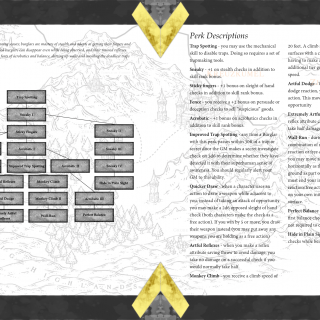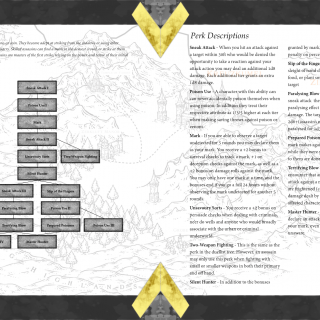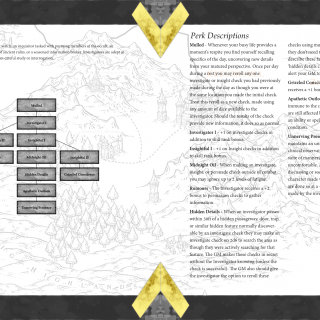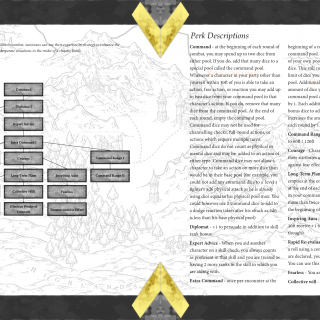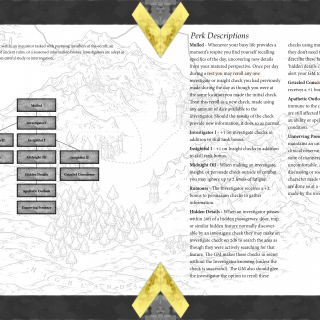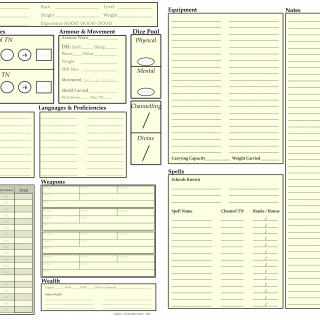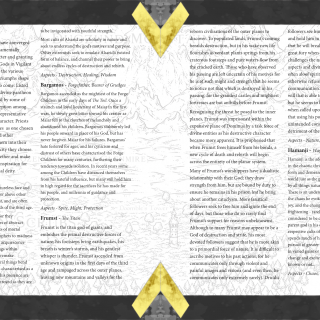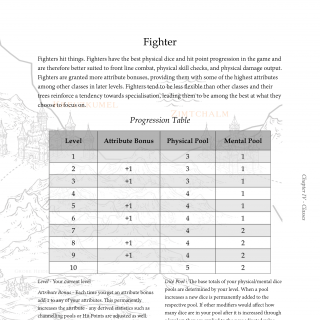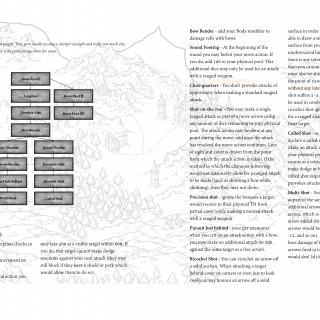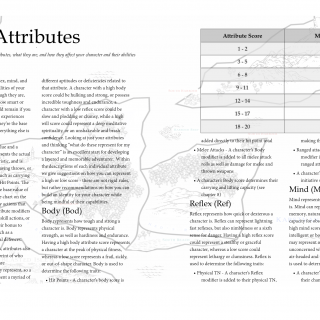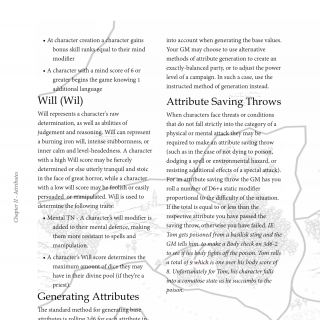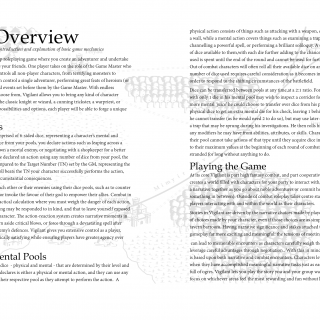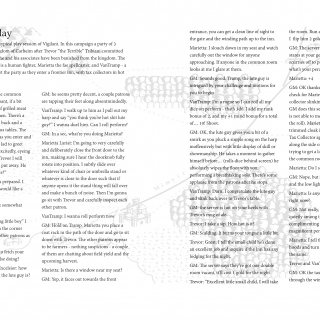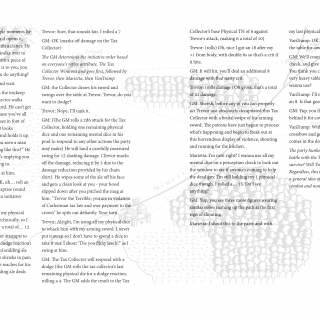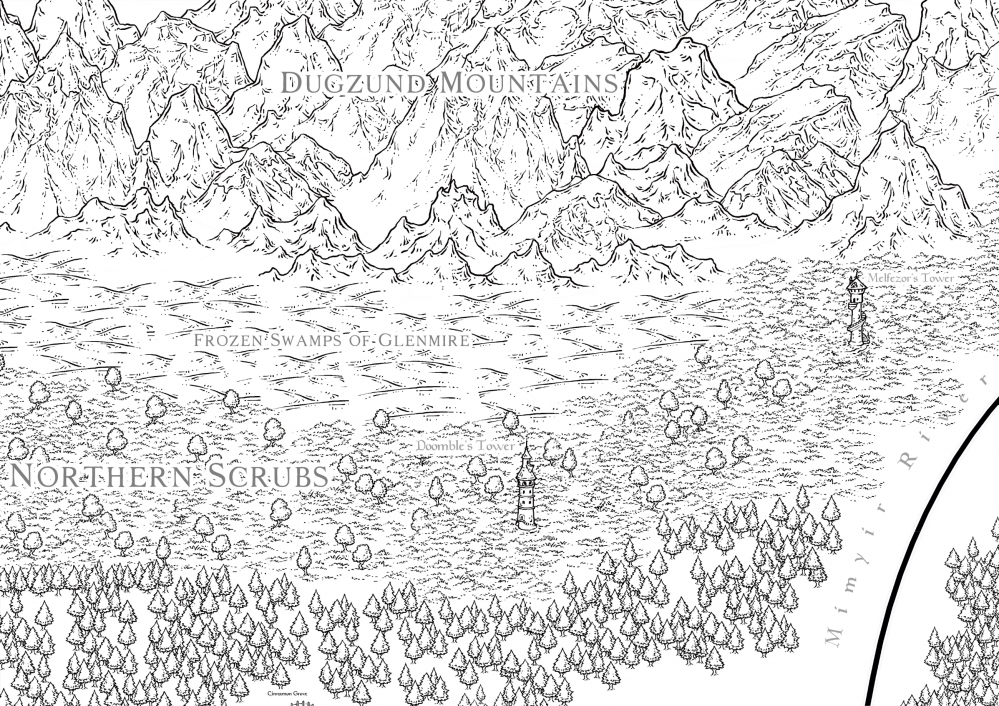
Vigilant RPG
Recommendations: 39
About the Project
Vigilant is a (mostly) setting-neutral fantasy rpg built for combat-addicted adrenaline junkies who crave a deep, tactically satisfying system with enough decision pathways to put someone into an analysis-coma. There are tons of viable character and combat approaches within a d6-based action-reaction system that is quick to pick up but provides boatloads of options for those who like to push systems to their limits. I'll go over game design, features development process, and other nonsense.
Related Genre: Fantasy
This Project is Active
The Rogue Archetype & Skill Trees
Archetype Overview
The Rogue is built to be the most flexible archetype – both inside and outside of combat. A rogue can build to specialize in numerous different areas, and their larger volume of skill points allow them to cover a range of specialties that other archetypes would struggle to keep up with. The innate archetype ability – roguishness – allows the rogue to treat physical or mental dice as either type when taking actions, so despite the archetype having the smallest dice pools they are able to take both mental and physical actions with comparable effectiveness to the spellcaster and fighter who have the most dice in either base pool respectively. As a newer player this makes them the easiest archetypes to play as it removes the mental burden of managing dice pools. Experienced players can find hidden layers of complexity within the rogue’s ability to manipulate their dice pools more efficiently than any other archetypes as by doing so a player can take advantage of numerous perks, items, and abilities that care about dice remaining in either pool.
Rogues also gain more skill points than any other archetype, which is from where they derive most of their out-of-combat flexibility in combination with supporting perks. As mentioned previously, there are only 18 skills in Vigilant, with each skill covering a broad range of applications. Bonuses to skills from ranks cap out at +10, and have diminishing returns based on the number of ranks invested, representing the natural plateau people reach in the pursuit of mastery, and the difficulty and investment required to break through such. It requires 21 ranks to obtain the full +10 bonus. The fighter and Priest only receive a grand total of 20 skill points from their progression, and cannot even obtain the maximum bonus even if they dumped all their points into a skill. Spellcasters on the other hand share their skill points between spells and skills, so although they get a total of 28 points to spend on skills, doing so would limit their ability to cast spells substantially. Rogues on the other hand receive a whopping 35 skill points by level 10, and therefore can specialize aggressively, or even spec into every single skill available with points to spare. Skill flexibility is meant to be one of the defining features of the rogue archetype, and it is expressed primarily through the volume of points available. Although many of the skill trees reinforce the Rogue as a reflex-based archetype, Rogues who emphasize a nontraditional attribute can still be very effective within the archetype should they choose to specialize in skills which take advantage of another bonus.
Skill Trees
Above are the four trees available within the rogue archetype! The assassin and burglar are the combat and noncombat trees respectively which contain abilities commonly found within classic TTRPG rogue progressions such as sneak attacks, lightning fast reflexes, and bonuses to hiding and pickpocketing. Taking a combination of perks from both trees will give you a character who is very comparable in playstyle to rogues from DnD and Pathfinder, whereas specializing in a specific tree will reward a character with powerful abilities at the expense of some flexibility.
A quick note on progression: although there is a ‘soft cap’ of level 10 within Vigilant, characters can continue to progress past level 10, but in doing so only receive a perk and skill points, and do not continue to increase Hit Points, Attributes or dice pools. The burglar tree is deliberately long to give a player plenty of options, and to represent a myriad of fantastical depictions of burglary from the skilled fence, to the acrobat, or a master of stealth. An extremely high level character can finish off an entire tree, but at early levels they will have to specialize – and this is indeed intended.
The investigator is meant to represent an occult investigator, or a Holmes-esque detective and is my personal favorite tree, as I find it leads to some fun gameplay. Mulled is my favorite perk in the entire game; it is not particularly powerful by any means, but it is a load of fun when a party makes there way out of the dungeon to rest and recover only for the investigator to realize in the midst of their rest that they missed a crucial detail such as a secret door, or that the prisoner they rescued was lying! and suddenly the party is forced into a situation where they have to fight their way back through a partially-cleared dungeon to uncover a missed secret. As a GM I personally love when my party backtracks, as it gives you a bunch of opportunities to show how the passage of time has impacted familiar areas. If a party has left a dungeon in ruins maybe areas are now collapsed and inaccessible, maybe the dungeon ecology has changed and new creatures have moved in, maybe the players take advantage of their foreknowledge and come back better prepared to tackle specific environmental challenges, opening up new ways to approach encounters. It’s usually a blast to run through old dungeons, and the very first perk in the tree provides plenty of opportunities to do so. ‘Hidden Details’ also allows the GM to cover-up any screw-ups by dropping the investigator the necessary information. Maybe you were expecting the party to investigate a specific area that they completely overlooked, so you tell the investigator about it during their opportunity to reroll, and can get the party back on track. At higher levels the Investigator becomes resistant to minor fear effects and gains a bonus to their mental TN. These are decently powerful effects on their own, but what I’ve found to be fun is player’s tendencies to find roleplaying justifications for their new immunities, such as a dead-inside private investigator, or a Scooby-Doo approach where the investigator believes every monster is a man-in-a-mask until proven otherwise.
The Tactician is one of the more complicated trees in the game, and characterizes the Rogue’s flexibility as leadership ability rather than individual ability. The Command ability allows the rogue to spend dice from either pool at the beginning of a round to add to a separate ‘command pool’ which they may then use to add to other friendly character’s actions or reactions during the round. Characters who go deep in the tree transform into excellent supporting classes, and usually the command pool encourages the rest of the party to take riskier actions, as they have a reserve of dice to fall back on in case things go sideways. It tends to dramatically change the way encounters play out, with parties becoming reliant on the bonus dice and fighting in tighter formations to remain within the Tactician’s buff range. Specializing in this tree reinforces those tendencies by adding some passive buff auras that adds to character’s mental TN and protects against fear.
That’s about it for the Rogue! I’ll cover the Priest and Spellcaster archetypes in future posts. As a reminder the Player’s Guide is now available for free on Itch.io, with the GM-facing rules well on their way for a mid-December drop. If you’re interested in running the game, drop me a message and I can hook you up with some rough-drafts of the Gamemaster Guide and some modules!
Release!
I’ve dropped the 1st edition of the player’s guide to Vigilant on Itch in PDF format! It’s free, and you can check it out right here.
It’s 188 pages of character creation, combat rules, equipment, spells, and gameplay, and covers all the stuff I’ve talked about here and a bunch more!
I’ll continue to rapid-fire my way through the archetypes, skills, and races, and then jump into some planned content and GM-facing rules! I had a post ready to go covering the Rogue archetype, but unfortunately google chrome ate my homework, so that will get pieced back together and dropped tomorrow hopefully.
Here’s some samples from the book, with the fancy new border!
Intro to Archetypes & The Fighter
What are Archetypes?
In Vigilant classes are divided into 4 broad archetypes within which are a number of specialized perk trees which a character can freely switch between. The four archetypes are: fighter, rogue, spellcaster and priest. Archetypes determine dice pool totals, hit point progression, skill point progression, and attribute bonus frequency. The way classes and leveling work is that within each of these archetype are a number of perk trees, and at level 1 and each level thereafter a character can choose a perk from any tree within their archetype so long as they have the previous perk, and then get all the normal bonuses from levelling up as listed in their archetype. The goal of this system was to pull the elements I liked from classless and class-based systems while preserving both game-balance and player choice as a design goal.
Within a class based system like classic dnd there is a clear sense of progression; characters improve at a constant rate, and even though they may not get a big flashy ability every level there are still consistent improvements to your character whether through attack bonuses, saving throws, or even just more hit points and skill points. When GMing class-based games that are fairly well balanced you also get an excellent metric of where to set encounter difficulty that is naturally baked into the system – monsters are statted appropriately against specific levels of characters. Classless systems sacrifice this linear sense of progression and balance for unparalleled flexibility. Invested players in a classless system can go nuts with spicy builds and make some truly unique characters, but classless systems are often daunting for new players, and difficult to balance for a GM as characters within the party do not progress at the same rate depending on how they spend their exp.
The Vigilant archetype system is looking to preserve the consistent progression and balance of class-based systems, while allowing for high amounts of flexibility through the ability to freely swap between perk trees. By defining dice pool progression archetypes provide some inherent balancing metrics, and signal what the archetype is meant to be good at which is then reinforced in their perk trees. For example, Fighters have the highest physical dice totals among the archetypes so their perk trees reinforce physicality and often make use of physical attributes and dice. The dice pool system itself is flexible enough that having consistent progression is not as limiting a factor in how the characters are played – a smart investigative fighter can be just as viable as a smart investigative spellcaster because the margins between their dice pools are fairly thin, and this gap can be closed with skill and perk investments. To add even more flexibility in builds there are also ‘general perks’ which are available to all archetypes and can be taken so long as a character meets their prerequisites. Some of these general perks are mini-trees in themselves, or else provide specific abilities to archetypes that don’t otherwise fit within a tree such as improved spellcasting. Through general perks characters can also ‘multiclass’ by gaining access to perk trees from other archetypes, allowing for extremely flexible builds at higher levels.
The point is to provide a bunch of flexibility in progression and play, while making these options digestible and balanced. A player can progress straight down a perk tree and get a similar class-experience as in dnd, while someone coming over from GURPS or HERO system can go nuts mixing and matching all the different perks throughout the various trees to build something unique. Because a character’s effectiveness is determined primarily by how they are played rather than just being the sum of their stats, both approaches can be equally viable. Although min-maxing will lead to an objectively better character with flashy ability synergies, a majority of the impactful systems are part of the innate archetype progression, so a min-maxed character will not stand head and shoulders above a character that just sticks to a singular tree.
Another thing to note is that progression of skill points and hp is static within an archetype – there are no dice rolls. Early levels of d20 systems can be extremely swingy as the difference between a high and low HP roll on your first 2 level-ups can be worth between 5-50% of your HP total. Although luck can be a lot of fun during character building, it usually feels pretty bad for luck to heavily impact character progression once they’ve hit the table, and so static progression is an effort to mitigate this.
The Fighter
Fighters get more physical dice and attribute bonuses than any other archetype because they’re supposed to be good at hittin’ stuff. Fighters start with the most Hit Points, and receive more at each level than any other archetype. Although fighters don’t get a fat stack of skill points, the most any class gets is 3.5/level, so they’re not exactly lagging behind. As you may have noted, there are no class skills – characters are free to toss points into whichever skills they want and skills themselves are quite broad – as there are only 18 unique skills in the game – so although 2 skill points may seem extremely limiting, they still provides a decent amount of options as most individual skills have a multitude of applications.
In addition to their progression tables, each class also has innate abilities that better define what the archetype is generally good at, or else define aspects that are essential to the archetype’s identity (such as spells for a spellcaster). Innate abilities are granted to a character of that archetype at character creation. For fighters these abilities are ‘student of arms’ and ‘feat of strength’. Student of arms is a small nod to speed ratings from AD&D, as my Dad continues to swear that speed ratings were the best initiative system ever developed and any system which does not emulate it is clearing doing it wrong. Initiative adjustments based on weapon size also serves as a signpost to say ‘hey, you’re better at weapons than other people, you should probably use those’, and also provides some interesting options in combat where a fighter can switch to a faster weapon to secure an advantage over an opponent. Feat of strength is another option for flexibility that is also a ‘get out of jail free’ card for when a fighter miscalculates and runs out of dice to make reactions. The downside to using this is ‘fatigue,’ which reduces a character’s dice pool by 1 until they rest. Fatigue can be applied to the mental or physical pool depending on the triggering event, and if it causes both pools to reach 0, or would otherwise exceed the base value of a pool then the character falls unconscious. Feat of strength provides a short burst of power to overcome a foe, or make that essential block reaction when trapped on the frontline. Some abilities or perks allow a character to mitigate the effects of fatigue, allowing for some synergistic build opportunities, but otherwise it is meant to be used sparingly.
That’s about it for me! Below are a couple examples of the perk trees found within the archetype. In addition to the ones shown there are also the Barbarian, and the Duelist in the base rules. Next time I’ll talk about the Rogue and Spellcaster archetypes and some of their trees and abilities.
How to Play - Attributes
The 4 Attributes
Body, Mind, Reflex, Will; 2 physical attributes and 2 mental attributes which in themselves represent the different facets of the physical and mental pools of the system. Attributes work the same as in many other RPGs – they have a base value which is used to calculate a number of derived statistics such as carry weight and initiative, and a modifier which applies to actions governed by the attribute. Body is how big and strong a character is, reflex represents nimbleness and agility, mind is intellect and observation, and will is wisdom, judgement, and courage.
Starting scores range between 1 and 13, with a modifier between -2 and +2 (as seen on the page previews below). Modifiers go up or down by one in base score increments of 3 with a +0 being associated with a base score of 6-8. It’s a little awkward in that there is no obvious formula to calculate the derived modifier, but the result produces a small range of working numbers to complement the small ranges in our combat, while still allowing us to implement some interesting mechanics using the base scores themselves. Attribute increases come as a character levels, and are dependent upon their chosen class; Fighters receive more regular attribute increases, while spellcasters receive the fewest, with priests and rogues sitting somewhere in the middle.
The Point of Attributes
Although I strongly believe that attributes are an iconic part of RPGs, I think there still needs to be some significant design justifications for their inclusion within a system, and there should be a balance in their usage and mechanical representation. System-wise Attributes are used within Vigilant to cut down complexity and eliminate areas that would otherwise be filled by additional mechanics or statistics, while still providing some balance knobs and build options that can be accessed by both the players and GM.
‘Saving throws’ – the classic ‘you’re affected by something, succeed on a roll or suffer the bad stuff – are something that I was struggling to implement in earlier versions in a satisfying way. Looking at other systems, 3.5e implemented saving throws as an entirely separate statistic which added to your d20 roll to beat a TN for the respective type of save. This wasn’t exactly confusing, but it added a decent amount of system bloat without adding a whole lot to the game, and Wotc moved away from this design in later versions by tying saving throws directly to attributes. I think there’s some arguments in favor of the ‘roll + associated modifier’ approach in that it maintains consistency across resolution systems (which is nice) but my major gripe is that it fails to substantially engage with the attribute scores, and frankly a lot of d20 systems are guilty of the attribute score being easily replaced with just a raw modifier. My favorite ‘saving throw’ mechanics are those in the various ffg warhammer roleplaying series where attributes are between 1-100 and saving throws are done on a per-attribute basis by rolling under your score to succeed on the save. I think this is super clean, as it makes the exact number of the attribute relevant, while still providing a smaller attribute bonus for use in other areas; it justifies the use of a score and a derived modifier. So Vigilant works in a similar way; saving throws are rolled on xd6 (depending on the difficulty of the save) and if the result is under the associated attribute the save is made. Initially I was experimenting with having the x value of the saving throw being the amount of dice the saving character had spent on actions that round, but that turned out to feel absolutely awful and encouraged characters to play extremely passive anytime there was something around that forced a saving throw.
The other advantage of the split score / modifier system is that the derived bonus can be used for a lot of stuff and serves as an excellent balancing tool. I seriously cannot understate how useful being able to throw a modifier at mechanic is from a design perspective. It serves as an excellent progress gate for powerful stuff, adds further depth to combat, adds layers to skill usage, helps players better define their character, gives an appropriate sense of proportionality, fine-tunes damage numbers or spell durations, and so much more. On a very simian level, we all get some kind of inane pleasure response from making big numbers by adding stuff together, and I think this is justification in itself for some form of bonuses.
Why these four?
I mentioned previously that attributes should be balanced in their mechanical representation. What I mean by that is each individual attribute should have a relatively equal role in gameplay and see a similar amount of use – even if that usage is confined to a (often touched upon) niche. That’s basically the reason there’s only four. I started with more, but could not for the life of me think of enough ways to use them in meaningful ways without either adding way too much system bloat or trivializing other attributes. My goal with attributes was to create a system in which there is no ‘dump stat’ and there was a clear advantage to maxing the hell out of any given attribute that would still lead to satisfying gameplay.
Body modifier is added to melee attack actions and damage, while the base score is added directly to a character’s hit point total. Body seems like the best attribute, but it really only shines in melee combat. Reflex bonus is added to ranged attack rolls and a character’s physical defenses, while the score determines a character’s initiative. Reflex is also used for most physical skills such as acrobatics and stealth, making it the ‘all rounder’ among attributes. Mind is used in more skills than any other attribute, and it’s total directly affects the amount of spells a spellcaster can use in a day. It also determines starting skill ranks and languages. At a glance, mind seems relatively weak but is absolutely essential for any skill-monkey character. Will modifier adds to a character’s mental defense, and its score is the most common saving throw commonly used to overcome fear or possession effects. Will is the most defensive of attributes, with it being effective in mitigating the effects of enemies and ensuring a character is always able to do what they want. It also governs the concentration skill, which affects a whole bunch of other skills and abilities.
As more attributes are added to a system they become either increasingly niche or increasingly complicated in their interactions and identity. I’ve played Rolemaster and I’ve played and GM’d HERO system and I could not tell you what half the attributes in either system do. Most players in my experience pick one or two that sound neat, and ignore all the other ones. On the flip side, if you’re Munchkin-ing out those systems, the builds themselves become so ridiculously obtuse and involve so many complex interactions that no one else at the table understands what you’re doing. From a development perspective it becomes nearly impossible to effectively balance these systems simply because there’s too many moving parts; the more interconnected systems you layer onto a game, the easier it becomes to break the hell out of it for an appropriately dedicated player. So in Vigilant the attribute volume is deliberately kept on the lower end to: a) keep things easier to understand, and b) make it easier to balance.
Initially I started out with 5 attributes; the current 4 plus ‘social’. Social got chopped because I couldn’t find enough things to associate with it mechanically without it feeling unnecessarily pushed and also because I realized that having an attribute govern social interactions restricts players’ abilities to roleplay effectively. The other part was there was some nice mechanical symmetry that came about accidentally by chopping out Social. Vigilant has 4 archetypes within which are a number of individual class trees that a character can freely swap between. The 4 archetypes – fighter, rogue, spellcaster, and priest – each have an attribute associated with them – body, reflex, mind and will respectively. This creates a nice ‘signpost’ when building characters for newer players, but allows those who break the mold with their builds to find spicy niches that go against archetype tropes.
Anyways, that’s about it. Here’s the page previews for Attributes! I’ll probably get into classes next time?
How to Play - the Core Mechanic
The Core Mechanic
It’s dice pools! This is not a particularly revolutionary approach, but the context and implementation make the difference. Every character has 2 pools of d6s – a physical and a mental pool. Using any number of dice from a pool a character can take any action that is governed by that pool, so for instance you could use 2 dice from your physical pool to roll an attack on 2d6, or 2 dice from your mental pool to try to pick a lock on 2d6. Like in many other games if the result of your roll + any modifiers beats the TN for the action then you successfully complete the action. The added layer is that characters can respond to actions taken by other characters and monsters should they have dice remaining in their pool to do so, so a character may dodge out of the way of an attack using a physical die, or counter a spell with some number of mental dice. In a pinch, characters can transfer dice between pools by spending 2 dice of one type to receive 1 dice of the other.
Characters will start with between 3-4 dice spread between pools depending on their class. The working range of numbers is kept fairly low at lower levels, so how characters use their dice in a given round is important and can change dramatically depending on how combat is going and what they are facing. An attack roll of 5 will hit most characters who lack the dice to dodge, and damage numbers tend to be high, making combat a careful tactical balance of wearing down an opponent’s defenses to get in for a bunch of damage while maintaining enough dice to defend yourself. And then there’s some inherent risk and uncertainty involved as you don’t know automatically other character’s dice pools – that ogre just blocked a swipe from my friend, can I assume he’s out of gas for the round and go in for a flurry of attacks or am I gonna get walloped on the ogre’s turn? Perks and class features add further ways to react or juggle dice around, and the end result is pretty darn fun with plenty of meaningful choices in a given round.
What’s the point though?
I started off as a little AD&D junkie, and eventually moved onto 3.5e which I’ve played most of my games in. Within those systems and d20s in general my biggest gripe as a player and DM was that combat if played by-the-book became repetitive and predictable – if you’re a fighter you would just move and attack every round, the only difference being the probability with which you’d hit, if you’re a wizard you sit at the back and toss out your strongest spell without any additional considerations. Class features and funky spells add some spice sure, but the only difference is that instead of attacking you just use your ability instead. Within the core rules players can have minimal consideration for what other characters and enemies are doing in a given combat, and generally will do the same thing every turn. If combat between 2 commoners just comes down to a raw calculation of probability that either character has minimal control over then I think there’s an issue. To make interesting combats in d20 you have to take interesting approaches that aren’t covered in the basic rules which requires the DM to come up with stuff on the fly – which can be a lot of fun sure, but I would prefer to have the option to do interesting nonstandard things and a combat system that is engaging on its own.
That deficiency is the primary design goal of Vigilant; to provide a combat system that has meaningful tactical considerations, provides diverse options, and is engaging in itself before any additional class features or system bloat is added on top of it. I think we got it. Combat is deep and interesting, and it’s been fun to just bounce generic characters off one another with different pool totals. People tend to have wildly different approaches to combat even with identical character builds which has been lots of fun, and the system can still accommodate players who just want to throw dice at the problem and not sweat the consequences. As characters increase in level they get more dice in their pools which in turn adds more options, so the game naturally climbs in complexity as you play it. This makes higher level characters more fun to play not because they’re just more powerful but because they have an exponentially greater number of things to do with that power. Basically there’s a bunch of depth if you want it without the system needing to be as complex as say RoleMaster
That’s about it from me! Here’s a chunk of the base book below that touches on the same stuff I just talked about. Next time I’ll talk about attributes or classes or something.










































